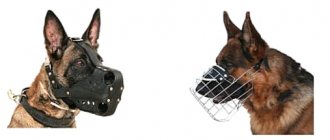How much should a puppy weigh?
The puppy's weight depends on the dog's breed and age. To roughly calculate the weight of a puppy of a certain breed, you can use the following table; for this you need to know the weight of an adult dog of a given breed.
| With the body weight of an adult puppy, kg. | ||||||||||
| 25 | 30 | 35 | 40 | 45 | 50 | 55 | 60 | 70 | 80 | |
| Puppy age | The puppy's weight should be equal to or lower than kg. | |||||||||
| 2 months | 6,5 | 7 | 8,5 | 9 | 10 | 11 | 12 | 13 | 14 | 15 |
| 3 months | 10 | 11 | 13 | 14 | 16 | 18 | 19 | 20 | 22 | 24 |
| 4 months | 13 | 15 | 17 | 19 | 21 | 23 | 24 | 26 | 29 | 31 |
| 5 months | 16 | 18 | 21 | 23 | 25 | 28 | 29 | 31 | 35 | 39 |
| 6 months | 18 | 21 | 24 | 27 | 29 | 32 | 34 | 36 | 40 | 44 |
| 7 months | 20 | 23 | 27 | 30 | 33 | 36 | 39 | 41 | 46 | 50 |
| 8 months | 22 | 25 | 29 | 32 | 36 | 39 | 41 | 44 | 50 | 54 |
| 9 months | 23 | 26 | 30 | 34 | 38 | 42 | 45 | 48 | 54 | 59 |
| 10 months | 24 | 28 | 32 | 36 | 40 | 44 | 47 | 50 | 57 | 62 |
| 12 months | 25 | 29 | 34 | 38 | 42 | 47 | 51 | 55 | 63 | 71 |
| 14 months | 30 | 35 | 39 | 44 | 49 | 53 | 58 | 66 | 74 | |
| 16 months | 40 | 45 | 50 | 54 | 58 | 67 | 76 | |||
| 18 months | 55 | 59 | 68 | 77 | ||||||
| 20 months | 60 | 69 | 78 | |||||||
| 22 months | 70 | 79 | ||||||||
| 24 months | 80 | |||||||||
More accurate data on the weight of puppies of some breeds is given in the following table.
| Breed of dog | Puppy weight (kg) at age | ||||||||||||
| 1 month | 2 months | 3 months | 4 months | 5 months | 6 months | 7 months | 8 months | 9 months | 10 months | 11 months | 12 months | Adult | |
| Bernese Mountain Dog | 2,5-4,5 | 6-10 | 11-17 | 15-26 | 20-33 | 25-37 | 30-42 | 34-45 | 36-47 | 37-49 | 38-51 | 38-52 | |
| East European Shepherd | 3,5-4,5 | 7-10 | 13-15 | 15-20 | 20-25 | 25-30 | |||||||
| Labrador | 3,4-3,8 | 7-8 | 12-14 | 17-19 | 21-22 | 24-26 | 26-28 | 28-30 | 29-32 | 30-36 | 30-40 | ||
| Rottweiler, males | 17 | 23 | 31 | 35 | 40 | 46 | 50 | 50 | 50 | ||||
| Rottweiler, females | 14 | 17 | 24 | 30 | 34 | 36 | 36 | 38 | 40 | ||||
| Toy Terrier | 0,2-0,65 | 0,32-1,05 | 0,46-1,55 | 0,6-1,9 | 0,7-2,2 | 0,8-2,2 | 1-3 | ||||||
| Chihuahua, Spitz | 0,2-0,6 | 0,3-0,95 | 0,45-1,4 | 0,6-1,75 | 0,7-2 | 0,76-2,25 | 0,9-2,7 | ||||||
If you know the weight of puppies of other breeds, you can indicate them in the comment form below, or provide a link to the source.
Table of growth dynamics of the lengths of the body, front legs and head
| Age (in months) | Oblique body length (cm) | Chest (cm) | Front paw length (cm) | Pastern girth (cm) | Head length(cm) | Muzzle length (cm) |
| 1 | 25-30 | 36-45 | 11-16 | 8-10 | 12-15 | 3-4 |
| 2 | 37-44 | 47-55 | 18-25 | 10-12 | 16-19 | 8-10 |
| 3 | 47-54 | 55-62 | 24-30 | 11-12,5 | 19,5-22 | 12-14 |
| 4 | 55-62 | 60-69 | 28-34 | 11,5-13 | 22-25 | 15-18 |
| 5 | 61-66 | 65-74 | 31-36 | 12-13,5 | 24-27 | 20-23 |
| 6 | 64-71 | 69-78 | 33-38 | 12-14 | 25-28 | 25-28 |
| 7 | 66-73 | 71-81 | 34-39 | 12-14 | 26-29 | 30-33 |
| 8 | 68-75 | 74-83 | 34,5-39,5 | 12-14 | 26,5-29,5 | 35-43 |
| 9 | 71-76 | 75-85 | 35-40 | 12-14 | 27-30 | 35-43 |
| 10 | 72-77 | 75-86 | 35-40 | 12-14 | 27-30 | 35-43 |
| 11 | 72-77 | 78-88 | 35-40 | 12-14 | 27-30 | 35-43 |
| 12 | 72-78 | 80-89 | 35-40 | 12-14 | 27-30 | 35-43 |
On a note! After reaching the age of 12 months, physical parameters do not change so significantly. Body weight changes at 8-10 months due to the growth of muscle mass, and the dog’s muscles continue to strengthen and develop. The angularity and fragility characteristic of teenagers disappears, the silhouette becomes more massive.
After 10-12 months, the gain continues due to an increase in the amount of subcutaneous fat. The girth and shape of the chest depend not only on the structural features of the skeleton, but also on the volume of the muscles of the dog’s shoulder girdle. Its indicators vary from 34-35 cm at one month of age to 80-89 cm at the age of one year. During the formation period, all physical parameters are dynamic, their ratio changes quite easily. To a large extent, they are determined genetically, but nutrition and general living conditions also affect the dog’s future complexion.
Source
How to determine the size of a dog by the age of the puppy
Another option is to calculate his future height and weight based on the puppy’s age and current parameters. On average, all dogs mature in a similar way, going through the same growth phases, so it's easy to know how big your puppy will grow to by knowing how many months old he is.
In the table you will see the percentage of the puppy's weight and height relative to the adult dog.
| Puppy age | Weight | Height |
| 1 month | 11% | 42% |
| 2 months | 23% | 58% |
| 3 months | 38% | 72% |
| 4 months | 51% | 80% |
| 5 months | 62% | |
| 6 months | 71% | |
| 7 months | 78% | |
| 9 months | 87% | |
| 12 months | 95% |
Let's give an example. Your pet is 4 months old, weighs 9 kg, and its height at the withers is 44 cm. Let's look at the table: at 4 months the puppy already has about half of its future weight and 80% of its height. This means that he will grow into a medium-sized dog, weighing approximately 18–19 kg and a height at the withers of about 55 cm.
Please note that large dogs grow slower than small dogs. Their full formation is completed only by the age of three, while the main period of growth still falls on a period of up to a year and there is no significant increase in growth beyond that. By the age of one year, dogs usually gain only 80–90% of their weight. So if your pet already weighs about 30 kg at six months, we can assume that its development will take a little longer and it will grow very large, perhaps up to 65–70 kg.
It is very important to monitor the correct physical development of such large puppies. It is generally accepted that a mongrel is by default healthier than its high-breed counterparts, but in reality this is not necessarily the case. Correct physical activity and a balanced diet are important for all puppies, but especially for large puppies, mistakes in raising can be fatal and lead to serious problems in the future. Overfeeding, slippery floors, careless jumps from great heights - all this, when the baby is large, often leads to injuries and diseases of the musculoskeletal system.
Miniature dogs, on the contrary, grow very quickly: already at 3 months they gain 50% of their weight, and by about 8 months they are considered fully formed. Therefore, if a puppy weighs only 1.5 kg at 4 months, we can assume that he has already gained about 60% of his weight, which means that his future body will weigh 2.2–2.4 kg.
Mini dogs also need increased attention from their owners. They, like any puppies, strive to explore and learn about the world, that is, they are curious, but at the same time they are also extremely fragile. Therefore, it is so important to ensure that the baby is not injured by negligence by people or other dogs, and also that he does not harm himself by jumping from high surfaces.
Most mongrels are moderately large dogs, not tiny or gigantic. Most often, adults weigh from 8 to 35 kg. You can determine the weight of such a dog using the table above with fairly high accuracy.
Stages of development of the German Shepherd
The process of growing up is characterized by signs. After its completion, body growth stops, all physiological characteristics that are characteristic of the breed are fixed.
Basis - intrauterine development
The fetus begins to develop in the mother's womb. After conception, the formation of the central nervous system and external data occurs in the female body.
Fetal development is affected by:
What do offspring inherit from their parents?
It is important not to confuse temperament and character. The dog will acquire the second in society - among relatives, next to a person, during training. A certain type of nervous system is transmitted to him from a bitch or dog.
The first two months of a pet's life
Puppies are born weighing 350–550 grams. Weight depends on the number of offspring in the litter (the more puppies, the smaller they are) and on gender (males are usually larger than females). In the first month of life, daily weight gain is approximately 100 grams. Thus, by the end of 4 weeks, babies weigh 2.5–4 kg. Their height ranges from 19–20 cm.
During the second month, puppies gain 160 grams daily, so by the end of the eighth week of life their weight is 8–9 kg and their height is about 41 cm. This is an excellent time to choose a suitable nickname.
It is worth noting that the first two months of life, the height and weight indicators of males and females are absolutely identical.
3 months
At 90 days, the puppies' suckling period ends. You can slowly start feeding your little friends what their mother eats. At this time they can gain weight from 12 to 18 kg. Of course, it’s not just the puppies’ weight that increases and changes. Their behavior is already becoming more adult, the “fluffies” are mastering the outside world, getting to know other pets, and thereby socializing.
Starting from this period, you can already train with the team’s favorite and raise the animal. It is important to pay more attention to your four-legged friend, communicate with him and play. After all, at 3 months, his behavior and further socialization depend solely on the owner.
The stage of childhood and adolescence is a period of intensive growth
A month or one and a half month old German Shepherd puppy finds a new owner and a new home. From this period, a new stage begins - the growing up of the young BUT, which will last (on average) up to 6 months.
During these weeks, a lot of significant events take place:
If the genes of the parents and good care of the mother were needed to give birth to high-quality offspring, then from the moment the puppy is adopted, you are responsible for matching the dynamics of its growth and weight.
For this, not only good feeding is important, but also mandatory communication with the new member of the flock - insufficient communication leads to reduced socialization. Reduced socialization inevitably leads to increased nervousness of the shepherd dog.
Increased nervousness affects the character of the dog (choleric), as well as its main development parameters: height and weight. Such a shepherd dog combines not only mental, but also physical retardation - decreased body weight relative to age (height-weight parameters do not correspond to age), thin bones ("bream"), excessive excitability (unpredictable behavior).
A German Shepherd that is prone to panic is a classic example of a weak type of VDN and does not match the breed’s exterior and is subject to culling. Such dogs can be helped (to some extent) by consistent therapy and training, but this dog will never have the full characteristics of those data that a full-fledged DO is famous for.
6–12 months - from adolescent to young shepherd dog
In the period from 6 months to a year, the growth of tubular bones practically stops, but the growth of flat bones is activated (the dog grows in breadth). The puppy is increasingly taking on the appearance of an adult. The formation of the organs of the reproductive system continues.
A six-month-old shepherd dog may be in her first heat. The male is ready for fertilization by the end of the 10th month. But mating should be avoided at this age, as it inhibits the processes of growth and development.
One and half year
How much should a German Shepherd weigh at 18 months? Its weight parameters do not increase much at this time, and at one and a half years old, an almost adult dog weighs 34.5 kg. She continues to gain muscle mass as she actively frolics in the fresh air and is exposed to physical activity.
Some owners take their one and a half year old dogs on vacation, where they swim in ponds. And this, as you know, has a strong effect on muscle growth, especially in the chest and limbs.
The last period is the formation of an adult shepherd dog
The period is considered completed by the year for the external exterior - the physical growth of the shepherd dog has ended. Depending on the type of nervous system and the development of temperament, individual maturation - the growth of a German Shepherd - can end at 2 years, and for some at 2.5-3.
Answer to the question: “To what age does a German Shepherd grow?” - George Bernard Shaw puts it best: “Any talent needs, first of all, attention and full development.”
Three years
Once a German Shepherd reaches three years of age, it is considered an adult. In size, it is comparable to other medium-sized breeds such as husky or labrador. At this time, she reaches maximum values in weight parameters and height, and she weighs approximately from 38 to 40 kg.
Classification by size
Small dogs
Small breeds of dogs (weighing up to 12 kilograms, height up to 28 centimeters) . These are mostly pets, but if we talk about dachshunds and terriers, due to their small size they can easily squeeze into the prey hole, so they are popular among hunters.
Small dogs are great for keeping in apartments and get along well with other animals and children if raised properly. They are quite easy to maintain; there is no need to make large financial investments.
But at the same time, small sizes imply increased excitability, so it is important to pay enough attention to training the animal. Many miniature dogs have a fontanel on their head, which often does not close with age. There may also be problems with teeth. Prone to allergies.
Small dogs are represented by the following breeds:
Medium dogs
Medium dog breeds (weight from 12 to 25 kilograms, and height from 28 to 60 centimeters) . This is the most universal and widespread category. Represented by hunting, service and decorative dogs, plus medium-sized dogs include poodles, English cocker spaniels, and beagles. They are almost never used for protection and shed heavily.
Border Collie – 12-20 kg
The Border Collie is a herding dog breed that is considered one of the smartest in the world. However, she can create chaos around herself if she gets bored. The Border Collie is a popular dog breed due to its appearance and medium body size.
A Border Collie can be an excellent companion, but only if its owner is able to cope with upbringing and provides the dog with constant physical and mental exercise. Do not underestimate this breed, because the border collie can easily outwit a person. Expecting your collie to spend his days in the backyard and his evenings watching your favorite TV shows is a sure way to end up with a barking, boring, destructive dog rather than a calm, kind and loyal companion. An improperly trained and poorly socialized dog may have difficulty interacting with children and other pets.
How to weigh a dog at home
Every owner wants to know...how much his dog weighs Jokes aside, any dog owner MUST know the weight of his pet. Information about the dog’s weight is necessary for vaccination, deworming and treatment - the calculation of doses of vaccines, anthelmintics and medications is done based on the animal’s body weight. When providing emergency medical care - for example, if a dog has been poisoned - it is extremely important that the owner knows how much it weighs: there may not be time or opportunity to weigh it, and the doctor needs to quickly choose the correct dosage of drugs to save the animal. It is also important to know whether the dog’s weight is normal before mating, as well as for participation in exhibitions. Data on weight dynamics (its changes over a certain period of time) can help with the formation of the correct diet for feeding a dog - a sharp increase or decrease in weight usually indicates serious health problems. Thus, it is recommended to weigh the dog periodically: a puppy weekly, an adult animal - at least once every 5-6 months, and always before vaccination, anti-parasitic treatment and medication administration.
How to determine a dog's weight? Today, many online stores selling pet products include dog scales. Their type and cost vary depending on the manufacturer and the class of breeds for which they are intended. So, if scales for weighing small dogs can be purchased at a price of 3,500 rubles, then scales for large dogs will cost at least twice as much, and they are much more difficult to find. At the same time, for many dog owners, such a purchase may be both impossible for financial reasons and unprofitable from a practical point of view: in fact, you will only need expensive scales to weigh your dog once or twice a year. That is why many dog breeders prefer to weigh dogs using “improvised means”, without unnecessary expenses.
There are several simple ways to determine a dog's weight at home. Small breed dogs, as well as puppies, can be weighed in a bag using a steelyard. To more accurately calculate body weight, you can weigh the bag separately and subtract this value from the total result.
You can weigh a medium-sized dog or puppy (15 to 25 kg) using ordinary floor scales, which are used to weigh people. To do this, pick up the dog and stand on the scale with him. Having remembered the resulting figure, weigh yourself without the dog - the difference between the first and second values will be the desired indicator of your pet’s weight.
It is more difficult to weigh a large breed dog (from 25-30 kg). The best option is to be weighed in a veterinary clinic, on specialized scales. If such scales are not found in the clinics of your city (which is not uncommon in small towns), you will have to use your wits :) For those families who, in addition to a large dog, also have a strong, large man living in the house, you can try weighing the dog together with him on a floor scale in the manner described above, which allows you to calculate the weight of the dog. If the dog weighs more than 50-60 kg, you will have to look for scales at the nearest market or train station: you will be surprised how many people will not be able to refuse you, touched by the sight of your small dog
Regardless of the method you choose to determine the weight of your four-legged friend, remember one simple rule: you can only weigh the dog on an empty stomach and after walking (when it has emptied its bladder and intestines).
The first days after birth
Many consider this short period in a child’s life to be the most touching. The kitten is born completely helpless: it is blind, does not hear anything and navigates the new world only by smells. By the way, studies have shown that, among thousands of other aromas, a small cat can smell the scent of its mother, who at that moment in a kitten’s life is not only the closest creature, but also a source of nutrition and care. The kitten does not yet know how to feed itself, so usually the animal, together with its brothers and sisters, is breastfed by its mother. The babies also don’t go to the toilet yet - the cat licks them. The kitten's fur is thin, so it often gets cold and needs to be warmed near its mother. The bones are also not yet strong, so it is not recommended to pick up, hug, or actively play with very small pets. A newborn cat baby weighs only about 100 grams and reaches a length of up to 10 centimeters. At the age of three days, the kitten loses its umbilical cord, and at five days the baby can already hear the world around him. Very small pets do not yet stand on their legs, but can already crawl around the room for short distances.
There is probably no person who does not know that newborn kittens are absolutely defenseless. They are born tiny, like little mice, blind and deaf. The only thing they need in the first weeks is their mother. She is with them almost around the clock, leaving only occasionally to eat and relieve herself.
On the 5th-6th day, the withered umbilical cord of the furry babies falls off. Eating, sleeping and periodically defecating are all they do in their young age. The cat tries to lick each kitten: thus, she cares for the offspring, maintaining hygiene and giving them regular abdominal massages, which helps stimulate sufficient excretion of feces and urine.
After three months of age, it is difficult to notice radically noticeable changes in the development of furry babies. True, they grow intensively for up to six months. From 12 weeks to 6 months, they undergo natural preparation for independent living, acquiring fundamental skills and abilities through constant play.
During this period, a feature of the psychological development of almost sexually mature adult cats is the building of a hierarchy. The determination of the leader and subordinate members of their society, which includes people, is an essential component of the relationship between animals of a given species and other inhabitants of the house. It is not surprising that upon reaching 6 months of age, having grown stronger and gaining sufficient confidence in their own abilities, they test the limits of what is permitted, often challenging the owner.
Classification of dog breeds by coat type
Why is it necessary to classify dogs by coat type? Everything is elementary - different types of fur require different grooming (frequency of washing, combing, haircut, trimming, use of various cosmetics, and so on). For the complete health of your pet, it is important to provide a competently selected range of procedures.
The main factors that determine coat type are the following:
Different combinations of these factors determine the diversity of dog coats. Let's look at them in more detail.
1. Degree of hairlessness
As a result of a number of genetic mutations that occurred in dogs, the phenomenon of hairlessness arose. There are many breeds of hairless (that is, hairless) dogs, which differ in the nature of the remaining hair, type of hair, structure, and so on.
Vivid examples include the Peruvian orchid, Xoloitzcuintle, Abyssinian desert dog, Turkish Greyhound, African elephant dog, Indian Rampur dog, Chinese Crested, American Hairless Terrier, etc.)
2. Nature of overgrowth
Animals vary significantly in this indicator. Some have hair of the same length, while others have different thicknesses in certain areas of the body. Classification of dog breeds according to this characteristic distinguishes animals with “wild” type, “brushed” type and mixed type hair.
Certain breeds that are close in appearance to their wild relatives—husky dogs, shepherd dogs, and so on—have retained their “wild” or “normal” natural coat type. It is represented by two-tiered fur (with the presence of undercoat), unequal length and texture of fur on different parts of the body. Usually this is a short coat that fits tightly in the area of the legs and muzzle, as well as longer hair with the presence of guard hair in the area of the withers, back, hind and upper legs, tail and sides. This is the most optimal arrangement of fur for wild animals.
In “big-breasted” dogs, hair growth is uniform throughout the body, as well as on the face and legs (this group of animals is represented by Commanders, poodles, soft terriers, Shih Tzu, South Russian Shepherds, etc.) In this case, more careful coat care will be required than for "wild" type.
In the case of an intermediate coat type, there will be uniform hair growth on the body and limbs, while the hair on the face will be shorter (possibly the appearance of a beard and mustache). Typical breeds include cockers, other spaniels, Afghans, etc.
3. Hair length
This is the next factor that determines the type of coat. All dogs can be divided into long-haired, short-haired, and also breeds with medium-length hair.
Long-haired breeds retain the typical differences in topcoat and undercoat (collie, retriever, Newfoundland), and may have almost no undercoat (setter). The hair of the longest-haired dogs (Afgans, Yorkies, Maltese, Shih Tzu) has almost no differences from the undercoat and is very similar to human hair.
English Bulldog – 18-25 kg
The Bulldog is a gentle family companion, but was originally bred for the sport of bull baiting. This dog combines loyalty and determination, thanks to which the breed has gained popularity. Few breeds are as easily recognizable as the bulldog, with its wrinkled face and undershot jaws.
The personality and temperament of the breed are almost ideal. The Bulldog loves children and is very easy to train, and is considered an excellent family pet. He is an endless source of entertainment, very affectionate, and attracts attention wherever he goes. In general, the Bulldog is an easy breed. Even the laziest owner can handle his exercise needs, and he doesn't tend to be a picky eater. This breed has a short coat that does not require much grooming, although there are some skin care needs. Last but not least, bulldogs need comfort and good air conditioning. This is not a breed that can or should live outdoors.
Classification according to the ICF version
This organization divides dogs by origin, working qualities and type.
Group 1 - herding and cattle dogs, except Swiss cattle dogs . This includes numerous types of shepherd dogs. Bred for herding work, which consists of forming and adjusting the herd.
Group 2 - pinschers and schnauzers - mastiffs and Swiss cattle dogs. The group is divided into several sections: pinschers, molossians, Swiss mountain dogs and herding dogs. Representatives of these breeds are used as service, decorative and herding dogs.
Group 3 - terriers. Includes 3 sections: large and medium, small, “boule” type, toy. Most terriers are hunters or companions.
Group 4 - dachshunds. The only breed in it has several types of coat. Also divided by size. Dachshunds were bred to hunt burrowing animals.
Portuguese Water Dog – 16-27 kg
The Portuguese Water Dog is a hunting, gun breed that loves attention, playing with children and swimming. He will happily do anything to help a person. The dogs do very well in obedience, agility, and other canine sports, and also enjoy boating, hiking, and playing with a ball.
This is a wonderful family dog and is generally good with children, although all interactions with children and pets should be supervised by an adult. She needs plenty of exercise and will be happy in an apartment, small country house or large mansion. Just don't expect her to cope with being alone in the backyard. If you choose this breed, make it a member of your family and not an outdoor dog.
Puppy weight table by month
A puppy weight chart can help you estimate how big that cute bundle of fur will be when he's an adult. However, it is not one size fits all, it depends on the size of the breed. So if you are asking yourself how big will my puppy be or just want to know the normal weight for a puppy by month? These puppy weight charts should help you out.
Are you concerned that your puppy is growing at an alarming rate? Or do you want to know how big your puppy will be when he grows up?
If yes, then here is a table of puppy weights for each breed size category, which should answer the question “puppy weight by month!”
You'll also get an idea of how much weight the average puppy gains each week, as well as what weight to expect at each stage. By using these charts, you'll know exactly what to expect as you get older.
How to measure height correctly?
You need to use several tools: a centimeter, a ruler, a tape, a square. The height of a dog can be determined by extending a centimeter (tape) along the animal’s body: the end is applied to the floor and extended to the withers.
Height is the distance from the dog's foot to the withers.
Metric information is collected from a standing dog. The animal must be in good spirits and not hungry. The best way to measure a Labrador is at home, in a calm environment; you can cheer him up with a treat.
Gradually the dog will get used to such manipulations and will respond well to them.
The height at the sacrum can be measured with a centimeter (tape, ruler) - from the floor to the highest point of the croup, in maclocs.
To make accurate measurements, the instruments must be placed at the correct points so that they fit against the animal's body, but do not press in. If the hair is long, then to accurately measure growth you need to part the hair and apply a centimeter (ruler, tape) to the skin.
To measure body length, first apply the end of the centimeter to the shoulder, then to the ischial tuberosity. When comparing actual sizes and standards, a special index is used, that is, an indicator of one dog parameter to another.
Growth in this case is the main factor; other results are correlated with it. For example, they distinguish the elongation index (body length to height) and boneiness (carpal girth to height).
IMPORTANT!
Indices allow you to judge whether a four-legged pet meets breed standards.
All data in breed tables are approximate . Sometimes puppies are already fully formed by the age of six months, and often continue to grow after a year.
If the height of a real dog does not coincide with the ideal parameters from the table, then there is nothing to worry about . The totality of all measurements, the general constitution of the dog’s body, is looked at.
This helps to monitor how your pet is developing. It is the height-weight ratio that gives experts an idea of how well developed the dog is, whether its ancestors were purebred Labradors or whether there was a crossbreed during mating.
At exhibitions, any measurements of an animal are allowed only in the presence of the owner . Service dog breeding usually operates with the indices of elongation and boneiness.
What to do if you have a mixed breed puppy
If you have a mixed breed puppy, you may feel like you are completely in the dark about knowing, or even just guessing, what weight your dog should be.
You can do this in two ways. You can take a look at all the weight charts on this page and see which chart is best for your puppy. Or if you wanted to be more precise, use a DNA test to see what breeds your puppy mixes with. Then you will know which puppy weight chart to use.
Wisdom Panel is a simple cheek swab test that will determine which breeds your puppy is crossed with, and there are over 250 breeds, types and varieties of dogs.
It can identify purebred ancestors going back three generations, giving you a good idea of what your puppy's weight will be.
© shutterstock
Dalmatian – 15-32 kg
Unique spots are the Dalmatian's calling card, and his ability to win makes him famous. The Dalmatian is an intelligent dog with a sly sense of humor. He is a clown and will do anything to make you laugh. He also has an endless capacity for exercise. The Dalmatian loves to jog: don't be surprised if he sneaks into your dresser, pulls out some running shorts and brings them to you as a not-so-subtle hint. Its high level of mobility makes it an excellent companion for people who are active. The Dalmatian loves attention and has a strong desire to please, so it is not uncommon for him to win in dog sports. He also excels at performing various tricks. Being part of a family is important to this breed. He likes to be with his people and know everything that is going on.
Like most dogs, Dalmatians get bored when left alone. They can easily become noisy or destructive if they don't have other dogs to keep them company and people aren't able to give them the proper amount of attention. Last but not least, it goes without saying that a people-loving dog like the Dalmatian should live in the home.
Weight of dwarf breed puppies
Let's start with the smallest quadrupeds. Toy breeds include, but are not limited to: Chihuahua, Chinese Crested, Maltese, Papillon, Pekingese, Pomeranian, Shih Tzu and Yorkshire Terrier .
On average, toy breeds gain approximately 5 - 10% of their body weight daily, which equates to approximately 30-150 grams per week. These tiny cuties grow much faster than larger dogs and usually reach the weight of an adult dog before they are eight to nine months old.
Below is a table that calculates the possible weight of your toy breed puppy based on birth weight, weighted by month.
Puppy weight chart - dwarf breed
These tiny cuties grow much faster than larger dogs and typically reach adult weight before eight months.
If you don't know your puppy's birth weight, you can still calculate his adult weight. Just look up his age (down the left column) and find the closest corresponding weight at that age, then go down that column to see what his weight will be as an adult.
For example, if you have a 12 week old puppy that weighs 680 grams, the closest one to it is 600 grams to 700, which means your puppy weighed between 80 and 100 grams at birth.
Another way to determine an adult puppy's weight is to take his weight at 6 weeks of age, double it, and then double it again. If you don't know what his weight was at that age (most of us don't), use the chart above again to find his current age and weight.
How to find out your pet's future size
If you become the owner of a mongrel, but know nothing at all about its parents, then you can try to calculate the approximate future size. To do this, you need to multiply the weight of a 4-month-old puppy by 2 or divide the current weight by the age in weeks and multiply by 52. Both methods do not guarantee 100% accuracy, but at least you will get approximate values.
IMPORTANT!
If a four-legged baby found on the street was severely emaciated, then until normal muscle mass is gained, its weight cannot be taken as a guide for calculations.
Many dog lovers often recommend another method - determining future sizes by the size of the paws. There is no point in following them. After all, a puppy’s large paws do not mean that he will become a giant. With a much higher probability, this external sign is explained by uneven development of the body in the first 4 weeks of life.
Classification of dogs by weight and size
You can create a classification based on the proportional size and weight of your furry animals. If you already have a dog, this information is no longer foreign to you. You probably already know that depending on the size of the breed, they vary the type of diet, special care and even personality.
The size and weight classification according to the Fédération Cynologique Internationale will be as follows:
- Giant breeds: weight over 50 kg.
- Large breeds: Weight from 25 to 50 kg.
- Medium breeds: Weight from 14 to 25 kg.
- Small breeds: Weight from 5 to 14 kg.
- Toy breeds: Weight less than 5 kg.
Don't forget that maintaining your dogs ideal weight is one way to prolong their lifespan, and you should do this with the help of your veterinarians at checkups at least every 6 months. Exercise and quality nutrition, depending on race and age, are the keys to success! Give your pet the best food for his breed and life stage.
Estimating a cat's weight.
You can roughly determine your physical fitness using a guide available at any veterinary clinic.
Overview of the cat's physical form (schematically):
Cat underweight
The lower limit of a cat's normal weight
Normal cat weight (ideal weight)
Overweight cat
Obesity
If it seems to you that your cat is getting fat, then start examining it regularly. Gently run your hands along her sides, trying to feel her ribs. With a cat of normal weight, you can easily feel the ribs. A small layer of fat on them should be palpable, which does not interfere with distinguishing each rib individually. If this is the case, then there is no reason to worry.
An obese cat is generally immediately obvious. She has a big belly, she can hardly walk, and she cannot lick herself completely. Often obesity is a consequence of a more serious disease, so it is worth contacting a veterinarian.
You need to help your cat lose excess weight. You cannot achieve sudden weight loss; the process should be gradual.
There are many foods available to reduce caloric intake. If feeding naturally, consult your veterinarian to determine an appropriate diet. It is easier to reduce the weight of a cat than for a person, since she has nowhere to go, just be firm and patient.
Please note that all this applies to an adult cat; kittens should not be restricted in their diet without the strict recommendation of a doctor. Kittens need all the food they can eat, including fat, to thrive.
Weight of small breed puppies
Small dogs generally grow faster than large dogs, but not as fast as toy breeds. They reach the weight of an adult dog between eight and twelve months.
The Charles Spaniel, French Bulldog, Jack Russell Terrier, Pug and Shetland Sheepdog are prominent representatives of small dog breeds.
In general, this includes breeds that range in size from 5 to 10 kg, but there is some overlap with the size of the dwarf breed.
Small breeds tend to gain weight at a rate of 5-10% per day, which is about 140-220 grams per week. Let's look at the weight of the puppies by month.
Weight of small breeds of puppies by month - table
Use this simple chart to determine how big your little puppy will be. Simply find the weight closest to your puppy's age and move down that column to see the age at 12 months, which is likely to be his adult weight.
To what age does a “German” grow up?
The growth of the “German” almost ends when he reaches one year. Subsequently, minor changes in growth and weight are possible due to an increase in muscle mass. If a dog physiologically becomes an adult by the first year of life, then its psychological development continues until two or three years.
Although many people say that the German Shepherd is a friendly pet, it always causes apprehension and a feeling of fear in me. My brother has had this guard dog for 10 years. There is a spacious enclosure and a large booth for him.
Their three-year-old child constantly plays catch and ball with the dog. But I am very wary of such entertainment, because you never know what might come to the mind of this “watchman.” I try to limit my child from any type of dog, even small indoor ones.
Giant dog breeds
Animals in this category include Akbash, Anatolian Shepherd, Great Dane, Irish Wolfhound, Deerhound, Spanish Mastiff, Tibetan Mastiff. The weight of individual individuals can reach 80 kg. The world's largest dog is a Great Dane named Giant George, whose weight was 111 kg; the dog died at the age of 8. Representatives of giant breeds are characterized by fast growth, but slow maturation. For this reason and because of their large body weight, they are prone to joint diseases. Compared to other categories of animals, giants live short lives. Well-mannered animals are friendly, gentle, and calm. Animals are more suitable for keeping in a spacious yard outside, as they require space.
- Changing teeth in dogs
- Change of dog owner
- How to determine a dog's age
- Big and small dog - who is better?
- How to choose a dog clipper
- Do dogs sunbathe?
Weight deviation from the expected weight and its impact on health
You need to know about the negative health consequences of both overweight and underweight pets. Excess weight above normal can cause various diseases (diabetes, cardiovascular and gastrointestinal diseases, arthritis) and reduce life expectancy. Obesity is especially dangerous for young cats. Insufficient weight appears due to poor feeding of the cat or due to the presence of certain diseases (metabolic disorders, diseases of the gastrointestinal tract, cancer) and can lead to the development of hypovitaminosis and exhaustion.
Weight of medium breed puppies
Medium breed puppies typically reach 99% of an adult dog's weight by nine to ten months of age.
In general, the average category consists of breeds that weigh between 10 and 20 kg.
There is some overlap with small breed size at the lower end of this scale and large dogs at the upper end.
Medium breed puppies consist of, but are not limited to: Border Collie, Bulldog, Cocker Spaniel, Corgi, English Springer Spaniel and Whippet .
For a dog that falls into the "medium" size category, you can use the month-by-month weight chart below to determine how much your puppy will weigh when fully grown. You can also see how much he will weigh at each stage, such as 12 weeks, 16 weeks, 6 months, 8 months and the like.
Weight according to standard
Experienced dog breeders know that the German Shepherd is a large breed. And this is determined not based on the dog’s height, but on its body weight. After all, animals that weigh more than 25 kilograms are considered large.
The normal weight of a shepherd dog, according to officially recorded standards, varies from 25 kilograms for girls (females) and from 35 kilograms for boys (males), and ends at 35 kg for females and 40 kg for males, respectively. An adult pet should have such parameters. If a pet deviates from them by at least one kilogram, it is a defect, which means it does not meet the breed standards.
The German Shepherd is a very smart dog. She can often be found in films, both as the main character and in supporting roles.
Weight of large breed puppies
Large breed puppies take at least a year to eighteen months to reach their full adult weight.
In general, the large breed category consists of breeds between 20 and 45 kg, but there is some overlap between medium sized breeds at the lower end of this scale and giant sized dogs at the upper end.
Large breed dogs consist of, but are not limited to: Alaskan Malamute, Boxer, Bloodhound, Doberman Pinscher, German Shepherd, Golden Retriever and Labrador Retriever .
To predict the weight of a large breed puppy at full growth, you can use the chart below to get a rough idea based on his current weight.
Weight of large breed puppies by month - table
Linear growth rates
Mostly cat lovers are interested in information about the fatness of Maine cats. Therefore, participants began to be weighed at exhibitions.
However, the data on how long Maine Coons are is no less interesting. Moreover, in many photos, owners try to demonstrate the size of the pet, taking pictures when it is stretched out in length.
The average height and length are as follows (in cm):
It also takes a Maine Coon 3-4 years to reach its full length. The largest representative of the breed listed in the Guinness Book is the cat Stewie. The length of his body from the tip of his tail to his nose was 123.2 cm.
Giant breed puppy weight
In general, the giant breed category consists of breeds weighing more than 45 kg, but at the lower end of the scale there is some overlap with larger breed sizes.
Large breed dogs consist of, but are not limited to: Bernese Mountain Dog, Bullmastiff, Newfoundland, St. Bernard, Great Dane and Irish Wolfhound .
Typically, giant breed dogs take longer to reach their adult dog weight, at least 12 to 18 months . Giant breeds that are on the higher end of the scale (ie Mastiffs, Great Danes, Newfoundlands, etc.) can even continue to grow until they are 2 or 3 years old!
These giant dogs usually gain about a kilogram per week, however the large puppies that are at the top end of the scale (i.e. Newfoundlands) gain approximately 1 – 2.5 kg per week).
Weight of giant breed puppies by month - table
To predict how much your giant breed puppy will weigh when he grows up, use the chart below to get a rough idea based on his current weight.
Not meeting height and weight standards
There is no need to be alarmed if a five-month or three-month-old dog “fluctuates” from the data in the height and weight table in one direction or another - he is still growing. It will be fully formed only by the age of 3 , when the measurements (height - length - girth - weight) will already be stable and constant.
Pay attention to the weight and height of your one-year-old Shepherd. At 1 year old, the puppy should weigh at least 30 kg, and not exceed the bar of 63 cm - this is the norm for this breed. Exceeding weight and height by more than 2 kg and 2-3 cm for a female or male (German Shepherd height by month and weight of a German Shepherd puppy in the table) indicates either the looseness of the dog (which is unacceptable for this breed) or casts doubt on purebred German Shepherd and its working qualities.











